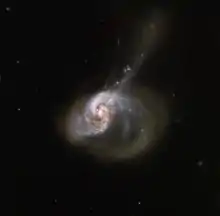| NGC 1614 | |
|---|---|
 Hubble Space Telescope image of NGC 1614 | |
| Observation data (J2000 epoch) | |
| Constellation | Eridanus |
| Right ascension | 04h 34m 00.027s |
| Declination | −08° 34′ 44.57″ |
| Redshift | 0.015938±0.000033[1] |
| Heliocentric radial velocity | 4,778[2] |
| Distance | 211.3 Mly (64.78 Mpc)[2] |
| Characteristics | |
| Type | SB(s)c pec.[1] |
| Notable features | Starburst galaxy with an active galactic nucleus |
| Other designations | |
| 2MASX J04340002-0834445, APG 186, IRAS 04315-0840, Mrk 0617, II Zw 015, PGC 15538 | |
NGC 1614 is the New General Catalogue identifier for a spiral galaxy in the equatorial constellation of Eridanus. It was discovered on December 29, 1885 by American astronomer Lewis Swift, who described it in a shorthand notation as: pretty faint, small, round, a little brighter middle.[3] The nebula was then catalogued by Danish-Irish astronomer J. L. E. Drayer in 1888.[4] When direct photography became available, it was noted that this galaxy displayed some conspicuous peculiarities. American astronomer Halton Arp included it in his 1966 Atlas of Peculiar Galaxies.[5] In 1971, Swiss astronomer Fritz Zwicky described it as a "blue post-eruptive galaxy, compact patchy core, spiral plumes, long blue jet SSW".[6]
In the De Vaucouleurs system for classifying galaxies, NGC 1614 has a galaxy morphological classification of SB(s)c pec. The SB indicates this is a barred spiral galaxy, while the '(s)' means it lacks a ring-like structure around the nucleus. The trailing 'c' describes the spiral arm structure as being loosely wound. The peculiar nature of the galaxy is noted with the 'pec.' abbreviation.[1] The galaxy is bright at the center, with two nearly symmetrical inner spiral arms.[7] It is a luminous infrared source,[8] with total infrared luminosity is 1011.60 L☉, ranking 55th in the 2003 IRAS Revised Bright Galaxy Sample,[9] and is the second most luminous galaxy within 75 Mpc.[10]
This galaxy is undergoing a minor merger event with a gas-rich, low-mass companion galaxy, located in a tidal tail to the southwest of the nucleus. The main galaxy is estimated to be around 3−5 times as massive as the merging object. The interaction between the two galaxies is triggering a burst of star formation in NGC 1614,[8] although not apparently an active galactic nucleus.[11] It is described as "one of the most extreme nearby starbursts".[10]
In the core region, a 230 pc radius ring feature has formed around the nucleus within the last 5−10 million years from an inflow of gas caused by the merger event, and this structure is the site of the intense star forming activity known as a starburst region.[7] This activity is bright enough that it is masking whatever weak nuclear emission there is coming from the core.[10] The nucleus itself displays evidence of an older starburst event.[7] The starburst activity is presumed to be driving an observed outflow of cold molecular gas that has a combined mass of around 32 million times the mass of the Sun.[11]
Two supernovae have been observed in NGC 1614: SN 1996D (type Ic, mag. 18.2),[12] and SN 2020cuj (type II, mag. 20).[13]
References
- 1 2 3 de Vaucouleurs, G.; et al. (1991), Third reference catalogue of bright galaxies, version 9, New York: Springer-Verlag.
- 1 2 Crook, Aidan C.; et al. (February 2007), "Groups of Galaxies in the Two Micron All Sky Redshift Survey", The Astrophysical Journal, 655 (2): 790–813, arXiv:astro-ph/0610732, Bibcode:2007ApJ...655..790C, doi:10.1086/510201, S2CID 11672751.
- ↑ Swift, L. (September 1886), "Catalogue No. 3 of Nebulae discovered at the Warner Observatory", Astronomische Nachrichten, 115 (10): 153–159, Bibcode:1886AN....115..153S, doi:10.1002/asna.18861151003. Entry no. 30.
{{citation}}: CS1 maint: postscript (link) - ↑ Dreyer, J. L. E. (2000), NGC2000.0: Complete New General Catalog and Index Catalog, NASA, retrieved 2016-03-18.
- ↑ Arp, Halton (November 1966), "Atlas of Peculiar Galaxies", Astrophysical Journal Supplement, 14: 1, Bibcode:1966ApJS...14....1A, doi:10.1086/190147. Entry no. 186.
{{citation}}: CS1 maint: postscript (link) - ↑ Ulrich, M.-H. (November 1972), "The compact central region of the galaxy NGC 1614.", Astrophysical Journal, 178: 113–118, Bibcode:1972ApJ...178..113U, doi:10.1086/151770.
- 1 2 3 Sliwa, Kazimierz; et al. (November 2014), "Around the Ring We Go: The Cold, Dense Ring of Molecular Gas in NGC 1614", The Astrophysical Journal Letters, 796 (1): 7, arXiv:1410.6982, Bibcode:2014ApJ...796L..15S, doi:10.1088/2041-8205/796/1/L15, S2CID 118498068, L15.
- 1 2 König, S.; et al. (May 2013), "The NGC 1614 interacting galaxy. Molecular gas feeding a "ring of fire"", Astronomy & Astrophysics, 553: 11, arXiv:1303.1012, Bibcode:2013A&A...553A..72K, doi:10.1051/0004-6361/201220453, S2CID 62891999, A72.
- ↑ Sanders, D. B.; et al. (October 2003), "The IRAS Revised Bright Galaxy Sample", The Astronomical Journal, 126 (4): 1607–1664, arXiv:astro-ph/0306263, Bibcode:2003AJ....126.1607S, doi:10.1086/376841, S2CID 14825701.
- 1 2 3 Pereira-Santaella, M.; et al. (December 2015), "Sub-arcsec mid-IR observations of NGC 1614: Nuclear star formation or an intrinsically X-ray weak AGN?", Monthly Notices of the Royal Astronomical Society, 454 (4): 3679–3687, arXiv:1509.07765, Bibcode:2015MNRAS.454.3679P, doi:10.1093/mnras/stv2242, S2CID 119270767.
- 1 2 García-Burillo, S.; et al. (August 2015), "High-resolution imaging of the molecular outflows in two mergers: IRAS 17208-0014 and NGC 1614", Astronomy & Astrophysics, 580: 21, arXiv:1505.04705, Bibcode:2015A&A...580A..35G, doi:10.1051/0004-6361/201526133, S2CID 38986586, A35.
- ↑ Transient Name Server entry for SN 1996D. Retrieved 30 March 2023.
- ↑ Transient Name Server entry for SN 2020cuj. Retrieved 30 March 2023.
External links
- "NGC 1614", The Hubble Space Telescope, NASA/ESA, April 24, 2008, retrieved 2016-03-21.